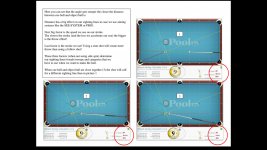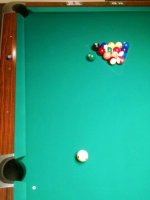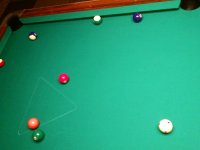The method is geared toward developing a feel for cutting balls. It covers shots
as thin as 1/8, but mainly focuses on recognizing the basic 1/4 increments. Then
when a shot falls between the basic increments, or thinner than a 1/4 hit, you know
without a doubt if it's 5/8, 3/8, or 1/8. Most often, on very thin cuts, a safety play is
a better choice if possible, at least until the player gets proficient at thin cuts.
A 1/4 ball is simple to hit by visualizing the edge of the shaft about an 1/8 away
from the OB. So when a shot comes up that you know is thinner than 1/4, you know
your shaft will have to be aimed further out, or you can aim for the 1/4 aim point and
spin the ball in (aim for the 1/4 aim point and use half a tip of outside english, or use
a full tip of inside english and trick it in.)
The book is also available as an E-pub or E-book for Kindle, Nook, etc... I believe
it's on the Apple I-bookstore for 9.99. Or http://www.lulu.com/spotlight/Poolology
as thin as 1/8, but mainly focuses on recognizing the basic 1/4 increments. Then
when a shot falls between the basic increments, or thinner than a 1/4 hit, you know
without a doubt if it's 5/8, 3/8, or 1/8. Most often, on very thin cuts, a safety play is
a better choice if possible, at least until the player gets proficient at thin cuts.
A 1/4 ball is simple to hit by visualizing the edge of the shaft about an 1/8 away
from the OB. So when a shot comes up that you know is thinner than 1/4, you know
your shaft will have to be aimed further out, or you can aim for the 1/4 aim point and
spin the ball in (aim for the 1/4 aim point and use half a tip of outside english, or use
a full tip of inside english and trick it in.)
The book is also available as an E-pub or E-book for Kindle, Nook, etc... I believe
it's on the Apple I-bookstore for 9.99. Or http://www.lulu.com/spotlight/Poolology
Last edited:



